Aquarium Conditioned
Diamond Watchman Goby
Valencienna puellaris
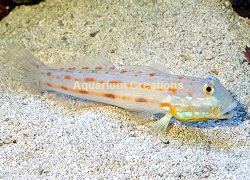
Click to view You Tube Video on the Diamond Goby
Description:
The Diamond Watchman Goby is also called the Orange Diamond Goby, the Pretty Prawn goby or the the Maiden goby. The Diamond Watchman Goby will usually dig a burrow underneath a rock in your aquarium, in which it will sleep and hide when frightened. Not only is it a very beautiful fish, but it is also quite beneficial for aquariums, since it will oxygenate the sand bed and stir up any waste. The name "Watchman" comes from their behavior in the wild, where they act as watchmen for the shrimp. The Diamond Goby is known to take an aquarium that has been ignored, filthy with detritus, and working non stop it starts passing the sand through its gills and makes the sand white again. It also seems to enjoy stacking sand in little mounds, which can be an interesting sight to behold.
Tank Recommendations:
The ideal aquarium should have plenty of room at the bottom and a sandbed of at least two inches in depth. When startled or threatened, they have been known to jump out of uncovered aquariums. Always keep the tank covered and provide plenty of hiding places to retreat to.
Food and diet:
They continually feed off the bottom while sifting through the sand. They also need to be fed a balanced diet of frozen foods including live and frozen brine shrimp, mysis shrimp, black worms, and other prepared foods for carnivores. We suggest feeding twice a day.
Level of Care:
Easy
Acclimaton Time:
2+ hours
Reef Compatibility
: Excellent
Approximate Purchase Size:
Small up to 1-1/2" Medium 1-1/2" to 2-/2" Large 2-1/2" to 3-1/2" XLarge 3-1/2" to 5"
|
Small$34.99
Medium $39.99
Large $49.99
XLarge $69.99
|
|
Aquarium Conditioned
Sleeper Banded Goby
Amblygobius phalaena
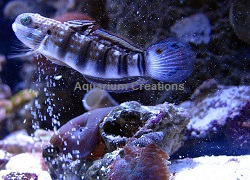
Click to view You Tube Video on the Diamond Goby
Description:
The Sleeper Banded goby is also called the Bullet Goby or Brown Barred Goby, this member of the Sand Cleaner Gobies gets to be one of the largest, attaining a maximum length of around 6 inches. A very hardy aquarium species it can be employed in a utility role in the reef aquarium as it will help keep the upper layers of live sand stirred by taking mouthfulls and then expelling it through its gills. Sleeper banded goby is a reef safe fish and helpful to the system as it feeds upon filamentous algae and keeps the sand oxygenated by sifting. It actually consumes the diatoms over the sand releasing the clean sand through its gills. The sleeper banded goby is rarely quarrelsome with other fish but they will fight with another Banded Goby unless your tank is large enough to handle two.
Tank Recommendations:
The ideal aquarium should have plenty of room at the bottom and a sandbed of at least two inches in depth. When startled or threatened, they have been known to jump out of uncovered aquariums. Always keep the tank covered and provide plenty of hiding places to retreat to.
Food and diet:
They continually feed off the bottom while sifting through the sand. They also need to be fed a balanced diet of frozen foods including live and frozen brine shrimp, mysis shrimp, black worms, and other prepared foods for carnivores. We suggest feeding twice a day.
Level of Care:
Easy
Acclimaton Time:
2+ hours
Reef Compatibility
: Excellent
Approximate Purchase Size:
Small up to 1-1/2" Medium 1-1/2" to 2-1/2" Large 2-1/2" to 3-1/2" XLarge 3-1/2" to 5"
|
Small$29.99
Medium $39.99
Large $49.99
XLarge $69.99
|
Aquarium Conditioned
Tiger Watchman Goby
Valenciennea wardii
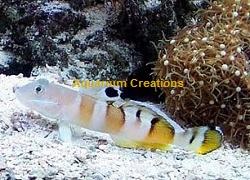
Click to view You Tube Video Tiger Watchman Goby
Description:
Also named the Ward's Sleeper, Ward's Tiger, or Tiger Sleeper Goby. Valencienna wardii is found in sandy areas of shallow lagoon and coastal bays of the Indo-Pacific region at depths of 15 to 60 feet. It uses shallow burrows in the substrate as refuge, keeping the substrate well oxygenated. They have a cream colored body with three wide brown bars along their sides, a neon blue band below each eye and a black spot on the first dorsal.They are burrow dwellers, and will normally seek protection under low overhanging rocks or actually burrow underneath rock to form a secure home. The name "Watchman" comes from their behavior in the wild, where they act as watchmen for the shrimp.
Tank Recommendations:
The ideal aquarium should have plenty of room at the bottom and a sandbed of at least two inches in depth. When startled or threatened, they have been known to jump out of uncovered aquariums. Always keep the tank covered and provide plenty of hiding places to retreat to.
Food and diet:
They continually feed off the bottom while sifting through the sand. They also need to be fed a balanced diet of frozen foods including live and frozen brine shrimp, mysis shrimp, black worms, and other prepared foods for carnivores. We suggest feeding twice a day.
Level of Care:
Easy
Acclimaton Time:
2+ hours
Reef Compatibility
: Excellent
Approximate Purchase Size:
Small up to 1-1/2" Medium 1 1/2" to 2 1/2" Large 2 1/2" to 3-1/2"
|
Small$44.99
Medium $49.99
Large $64.99
|
|
|
Aquarium Conditioned
Golden Head Sleeper Goby
Valencienna strigata
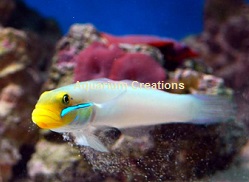
Click to view You Tube Video Golden Head Sleeper Goby
Description:
With a pearly white colour for the body and a yellow face with a blue stripe across the cheek. It is an easy-to-keep fish and makes an ideal introduction to gobies as long as there is enough substrate for them to sift through. The Golden-headed Sleeper Goby, Blueband Goby, or Pennant Glider are not only pretty fish, but are great for a marine environment where you want the substrate to constantly be sifted through. These fish really use their mouths! They are constantly digging and turning over the sandy substrate. Besides this ongoing activity of "chewing" the sand, these gobies can communicate with each other by producing signals with their mouths.
Tank Recommendations:
The ideal aquarium should have plenty of room at the bottom and a sandbed of at least two inches in depth. When startled or threatened, they have been known to jump out of uncovered aquariums. Always keep the tank covered and provide plenty of hiding places to retreat to.
Food and diet:
They continually feed off the bottom while sifting through the sand. They also need to be fed a balanced diet of frozen foods including live and frozen brine shrimp, mysis shrimp, black worms, and other prepared foods for carnivores. We suggest feeding twice a day.
Level of Care:
Easy
Acclimaton Time:
2+ hours
Reef Compatibility
: Excellent
Approximate Purchase Size:
Small: up to 2" Medium: 2" to 3" Large 3" to 4" XLarge 4" to 5"
|
Small$29.99
Medium $39.99
Large $54.99
XLarge $74.99
|
Aquarium Conditioned
Bluespotted Watchman
Cryptocentrus pavoninoides
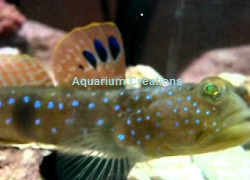
Click to view You Tube Video Bluespotted Watchman
Description:
The Blue Spotted Watchman Goby, Cryptocentrus pavoninoides, occurs in two color variations, which some believe to be sexual color variations. One variety is gold with black bars on its body and blue spots on its head. The second variation and the one we are shipping is a golden-yellow fish with Irradecent blue spots on the head trailing throughout the body. One of several Shrimp Gobies that if present, will gladly share its sand bed burrow with a Pistol Shrimp of the Alpheus genus. It will also build burrows in the absence of a Pistol Shrimp; helping to keep the sand bed well stirred.
Tank Recommendations:
The ideal aquarium should have plenty of room at the bottom and a sandbed of at least two inches in depth. When startled or threatened, they have been known to jump out of uncovered aquariums. Always keep the tank covered and provide plenty of hiding places to retreat to.
Food and diet:
They continually feed off the bottom while sifting through the sand. They also need to be fed a balanced diet of frozen foods including live and frozen brine shrimp, mysis shrimp, black worms, and other prepared foods for carnivores. We suggest feeding twice a day.
Level of Care:
Easy
Acclimaton Time:
2+ hours
Reef Compatibility
: Excellent
Approximate Purchase Size:
Small:up to 1-1/2" Medium: 1-1/2" to 2-1/2" Large 2-1/2" to 3-1/2" XLarge 3-1/2" to 4-1/2"
|
Small$49.99
Medium $53.99
Large $64.99
XLarge $79.99
|
Aquarium Conditioned
Bella Goby
Valencienna bella
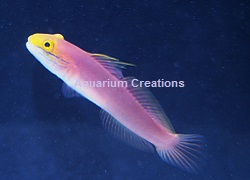
Click to view You Tube Video Bella Goby
Description:
The Valenciennea bella is a gorgeous,rare and hardy species found both singly or in mated pairs. They are a new and exciting addition to the reef tank. A beautiful maroon and red coloration, they are certainly beautiful and much much more attractive looking compared to all other standard aquarium sand sifting counterparts. The Bella Goby is collected in the reefs and sandy bottoms of Japan and Cebu.
Tank Recommendations:
The ideal aquarium should have plenty of room at the bottom and a sandbed of at least two inches in depth. When startled or threatened, they have been known to jump out of uncovered aquariums. Always keep the tank covered and provide plenty of hiding places to retreat to.
Food and diet:
They continually feed off the bottom while sifting through the sand. They also need to be fed a balanced diet of frozen foods including live and frozen brine shrimp, mysis shrimp, black worms, and other prepared foods for carnivores. We suggest feeding twice a day.
Level of Care:
Moderate
Acclimaton Time:
2+ hours
Reef Compatibility
: Excellent
Approximate Purchase Size:
Medium 2" to 3" Large 3" to 4"
|
Medium$124.99
Large $139.99
Certified Mated Pair $349.99
|
|
| |






